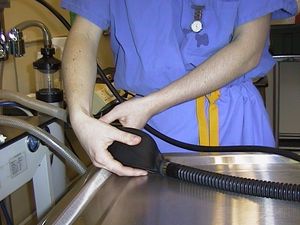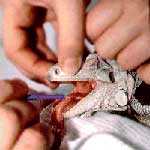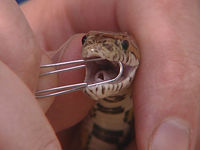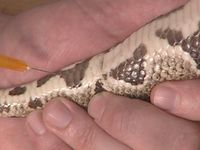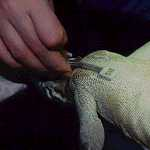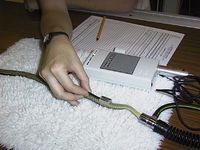Lizard and Snake Anaesthesia
Introduction
Reptiles are becoming more popular pets and so it is becoming increasingly important to understand handling and treatment for these species. They pose a number of different issues compared to that of other domestic species, for example, some may be more dangerous to handle, and so careful selection of agents is required with the ideal providing muscle relaxation, analgesia, easy control and is both safe for personnel as well as the patient. There are also variations in anatomy compared to that of other domestic species. These include the simple sac like structure to lizard and snake lungs.
- For information on lizard and snake surgery, see Lizard and Snake Surgery.
- For information on how to inject a lizard, see Lizard Injection.
General Considerations
Changes in temperature can affect physiological systems of reptiles and so temperature regulation is an important consideration when any reptile is hospitalised. During any procedure, the patient should ideally be maintained at their optimum temperature. As many anaesthetic agents are metabolised and/or renally excreted, it is important to maintain the patient's body temperature as these organs can also be affected thereby prolonging recovery from anaesthesia.
Respiratory rate decreases with increasing oxygen partial pressure (not decreasing carbon dioxide partial pressure as in mammals). Snakes may not spontaneously breath under general anaesthetic especially when on 100% oxygen.
Preanaesthetic Considerations
As with any species, a full clinical examination is important before any anaesthetic procedure. This allows for detection of any abnormalities and correction of these before continuing with the procedure.
- Atropine as a premedicant is considered unnecessary except in small reptiles since salivary excretions are generally not a problem.
- Intake of food and water should be monitored so that they can later be used to assess the postoperative recovery.
- Lizards: as regurgitation is rare in these patients, starvation is not necessary.
- Snakes: regurgitation is more likely to occur in a snake that has recently fed, therefore fasting is recommended if the snake's condition allows it. Duration is related to the size of the animal and the frequency of feeding; this may be from 12 hours upwards.
- The use of water baths or electrolyte solutions in the days prior to a procedure may be beneficial in ensuring that a suitable state of hydration is present.
- As in any species, stress should be kept to a minimum, and preplacing a catheter before induction is recommended.
- Intubation of reptiles, compared to some other species, is relatively simple due to the glottis being clearly visible but it is necessary to wait until the glottis is open.
Although the pharmokinetics are not known it is probably worthwhile giving analgesics and anti-inflammatories. Carprofen is the NSAID of choice and analgesics that are being used include butorphanol and buprenorphine.
Antibiotics and fluids may be indicated.
Induction
Induction can be by parenteral injection or gaseous inhalation and the anaesthetic agents are the same as used in mammals.
Parenteral agents include intravenous Propofol and Saffan or intramuscular ketamine. Gaseous agents include isoflurane and halothane which may be administered with an induction chamber or face mask.
- Propofol may be used for induction. It is an excellent anaesthetic if you are competent with IV injections. The anaesthesia may be continued with additional doses of 10% of the original or, more preferably, by isoflurane inhalation
- The constituents of Saffan are alphadolone acetate and alphaxalone. It has been superceded by propofol as an IV anaesthetic.
Maintenance
Isoflurane is the agent of choice for maintenance of anaesthesia. Intermittent positive pressure ventilation (IPPV) is necessary. Propofol by slow intravenous or intraosseous administration can also be used.
- For snakes, consider the use of medical grade air rather than 100% oxygen since breathing may be more spontaneous. An IPPV rate of two to four ventilations per minute is usually adequate. Over-inflation may damage the lungs so care is necessary as only the first two-fifths of the body is inflated with each ventilation. Increased visceral volume leads to decreased tidal volume so gut contents, eggs and any mass-occupying lesions may affect the anaesthesia. After induction of venomous snakes it is advisable to tape the mouth closed with extreme caution! Do not sheath the fangs since accidental trauma is very likely.
Where possible, anaesthetised reptiles should be kept in sternal recumbancy, to help with circulation and prevention of hypotension developing. It is also important to maintain the patient at its ideal temperature throughout the anaesthetic.
Monitoring
Monitoring the depth of anaesthesia can be difficult in reptiles but may of the same reflexes and response can be monitored as in other domestic species.
Physical reflexes are especially important since lizards at a plane of surgical anaesthesia may suddenly appear fully awake. This probably occurs from trying to maintain the snake/lizard as light as possible. Reflexes and responses include:
- Toe and tail pinch.
- Head withdrawl - Toe is pinched and head is slightly withdrawn.
- Palpebral response.
- Vent response.
- Tongue response.
- Corneal response.
- Jaw tone.
As in other species, cardiovascular and respiratory systems should also be closely monitored. The most important anaesthetic monitoring aid is a Doppler blood flow monitor. A pulse oximeter and an electrocardiograph may also be useful. Advanced monitoring aids include blood gas saturation and capnography. The heart rates of lizards are relatively slow. Normal readings are about 50 bpm. Although readings for pulse oximetry may drop below 70%, aim for haemoglobin saturation above 90%.
Recovery
Once the procedure is finished and the vaporiser is turned to 0% consider using air for ventilation if the snake has been on 100% oxygen. Spontaneous breathing will return more quickly. Use a dark, quiet post-operative environment within the reptile’s preferred optimum temperature zone (POTZ). Give fluids to maintain hydration.
- Doxapram hydrochloride is an effective respiratory stimulant and can be used in apnoeic snakes.
Recovery can take between 10-30 minutes on average in reptiles.
- The patient should be minimally handled or stimulated as to prevent cardiovascular problems.
- Hypothermia can be a major cause of prolonged recovery as previously discussed. However, care should be taken to make sure that the patient is not overheated as this may lead to necosis and metabolic disturbances.
Monitoring of the patient should continue until full normal function is obtained, and provision of oxygen or room air via assisted ventilation may be necessary until spontaneous breathing has returned. The patient may appear to of recovered and then gone back to an "re-anaesthetised" state and rest for periods during recovery. Full recovery may take up to 24 hours.
| Lizard and Snake Anaesthesia Learning Resources | |
|---|---|
 Search for recent publications via CAB Abstract (CABI log in required) |
Reptile Anaesthesia publications |
 Full text articles available from CAB Abstract (CABI log in required) |
Snake anesthesia and surgery. Hernandez-Divers, S. J.; The North American Veterinary Conference, Gainesville, USA, Small animal and exotics. Proceedings of the North American Veterinary Conference, Volume 22, Orlando, Florida, USA, 2008, 2008, pp 1767-1771, 5 ref. |
| This article has been peer reviewed but is awaiting expert review. If you would like to help with this, please see more information about expert reviewing. |
Webinars
Failed to load RSS feed from https://www.thewebinarvet.com/anaesthesia-and-analgesia/webinars/feed: Error parsing XML for RSS
